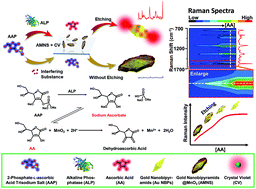Enzyme activity-modulated etching of gold nanobipyramids@MnO2 nanoparticles for ALP assay using surface-enhanced Raman spectroscopy†
Abstract
The detection of enzyme activity can provide valuable insights into clinical diagnosis. Herein, we synthesize gold nanobipyramids@MnO2 nanoparticles (AMNS) as the surface-enhanced Raman spectroscopy (SERS) substrate for the first time and design a “turn-on” SERS strategy for the detection of enzyme activity without the need for a complicated SERS nanotag preparation process. In the presence of alkaline phosphatase (ALP), 2-phosphate-L-ascorbic acid trisodium salt (AAP) can be hydrolyzed to ascorbic acid (AA), which can etch the shell of AMNS by reducing MnO2 to Mn2+. The cracked MnO2 shell-caused electromagnetic field enhancement from AMNS can give rise to a significant increase in the Raman intensity of the adsorbed molecules (i.e., crystal violet, CV) on the surfaces of nanobipyramids. Thus, the ALP activity can be accurately quantified based on the MnO2 shell thickness dependent Raman signal output from CV. A linear dynamic range from 0.4 to 20 mU mL−1 with a detection limit of 0.04 mU mL−1 is achieved, which is more sensitive than other spectroscopic methods for ALP detection. Because of its advantages of sensitivity, convenience and versatility, this approach provides a new perspective to disease-related biomolecular detection in the future.



 Please wait while we load your content...
Please wait while we load your content...